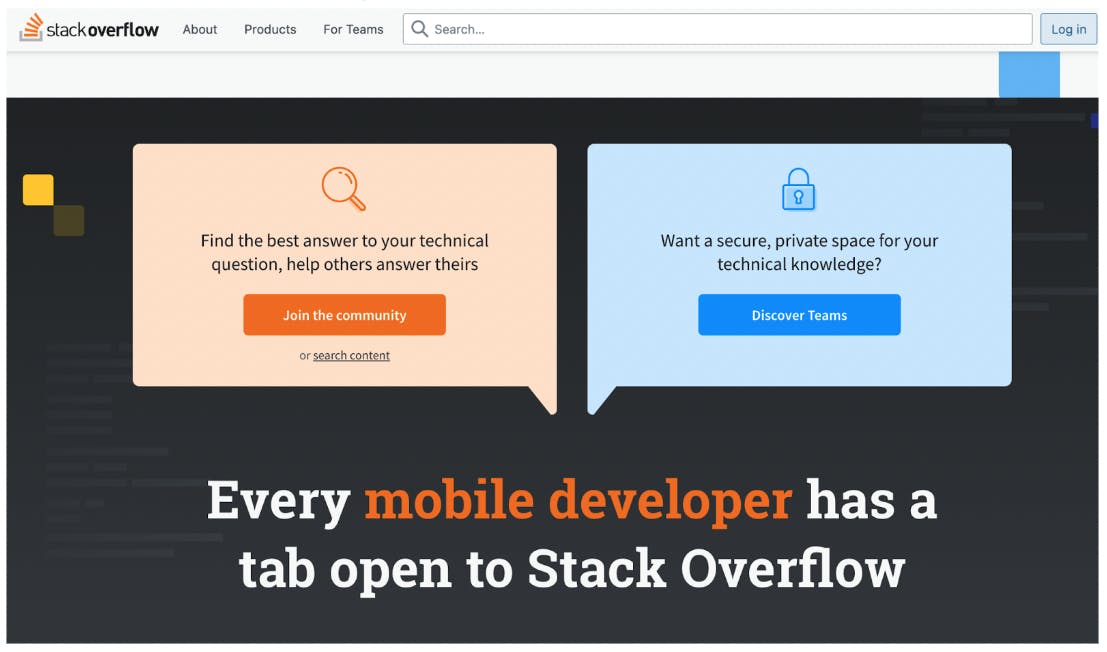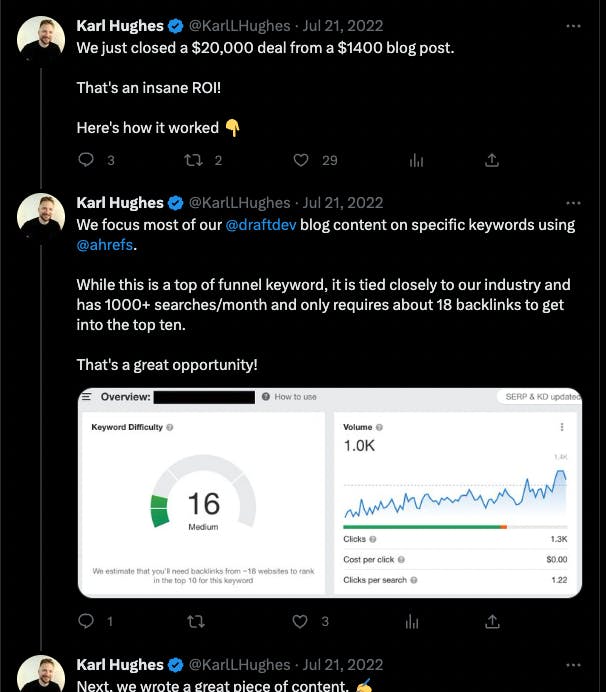How To Build A DevTools SEO Content Engine from 0 to 30k views in 6 months
Creating Developer-Focused Content That Ranks
A few years ago, before starting Draft.dev, I was talking with someone in Developer Relations at a big tech company. He mentioned that they pay engineers upwards of $1000 to write a single blog post.
This seemed like a lot of money, but as I started digging deeper, it became clear that this was actually a fantastic investment. While they put a lot into each post, his team knew how much traffic they’d get from it and how many trials and paid conversions that traffic would typically lead to.
“An average blog post will lead to $10,000 in recurring revenue each year,” my friend told me. “And a really good one might bring in an enterprise deal that’s work $100,000 or more.”
Admittedly, these results are difficult to replicate. This company has a deep library of existing content, high domain authority, a very refined lead-capture funnel, and a whole team doing keyword research and quality control. But, because this kind of content is so hard to produce, there are still a lot of opportunities for developer-focused content.
While there are plenty of reasons developer tools companies should create content, getting traffic and leads from search engines is certainly one of the most consistent ways to ensure a strong return on investment. Companies like Twilio and Digital Ocean have built their marketing engines on content, and many of the companies we work with at Draft.dev are doing the same. In fact, we get many of our clients from search engines.
In this post, I’ll share some of the specific methods developer tools companies are using to climb search engine rankings. I’ll share a bit about how to choose the right keywords and compare four different types of content (not just long-form writing) that can work. By the end, you should have a stronger understanding of how to consistently attract developers through search engines and some frameworks to build on!

Choosing the Right Keywords
When a user types a search into Google, Google tries to deliver the most relevant, correct, and complete results for that particular keyword and individual. While determining result rankings is an extremely complicated (and black box) procedure, you can help your content perform better by intentionally targeting specific keywords on each page of your website.
We’ve worked with over 100 clients, and most are relatively new to developer marketing. Some are technical founders or former developers who now run a Developer Relations team. Others are marketers who are trying to learn all the vocabulary required to reach developers.
In either case, they struggle to come up with keywords that are (1) being searched for by developers, (2) relevant to the problem their product solves, and (3) not so saturated that their content will never rank. Keyword research is a little bit art and a little bit science, but it’s also a well-established best practice that you can learn.
Use Data
First, you don’t have to guess how many readers might be searching for a particular keyword or phrase each month. You can use keyword research tools (Ahrefs and Moz being the most popular) to estimate monthly search volume and the difficulty you’ll have in reaching the first page of Google.

While their data isn’t perfect (it’s historical and based on a limited number of searches), Google doesn’t release search data, so it’s the best we have.
Understand the Technical Context
Anyone can use Ahrefs to figure out which keywords have strong search volume and low ranking difficulty. The hard part is knowing which keywords are actually appropriate for the technical context in which your users operate. This is why many marketers struggle with developer-focused content.
For example, Ahrefs might tell you that there is a lot of search traffic around “Docker Machine” because it’s using historical data to estimate future searches. But, Docker Machine was deprecated, so it might not very valuable to rank for it anymore.
If you’re a non-technical marketer, just make sure you’re running keywords by subject matter experts in your organization so they can help you avoid mistakes like this.
Target the Right Point in Your Funnel
It’s tempting to target the highest volume search terms you can find, but there’s usually a tradeoff between volume and purchase intent.
For example, there might be thousands of people searching for “What is a Data Engineer?” each month. But, what do these searchers really want? Are they trying to hire someone? Are they looking for a new job? Are they hoping to find a new data pipeline tool?
We really don’t know. This kind of broad, informational content is typically called top of funnel, referring to the top of the marketing funnel. It generally has more search volume, but we don’t know what the searcher is looking to purchase (if anything).
On the other hand, the keyword “snowflake alternatives” is solidly middle of funnel. Searchers are evaluating data warehouses by gathering information about competitors, and want something comparable to Snowflake. If you’re a new entrant to a market, these keywords are great because while they have less volume than top of funnel keywords, they’re much closer to purchase intent.
Finally, some terms sit at the very bottom of the funnel, meaning the searcher is already aware of your solution, but simply evaluating whether it’s right for them. A keyword like “salesforce redshift integration” is a good example as searchers are likely already Salesforce customers, but not sure if they can use it with Redshift. Because these terms are typically very low volume, they often barely register in tools like Ahrefs, but they can be extremely valuable to the company being researched.
To decide which stage of the funnel you should focus your content, you need to think about your marketing goals. If you have lots of leads coming in, but very few conversions, focus on the bottom of your funnel. If you have very few leads, but your small userbase loves your product, you need to build the top of your funnel.
Target the Right Audience
Similarly, you need to understand your intended audience. We see a lot more search volume around junior-level topics than senior-level ones, but most of our clients would prefer to reach senior developers as they’re typically decision-makers.
So a term like “what is reactjs?” might have a lot of search volume, a term like “concurrent mode react” (a newly released feature) might attract more experienced developers. It has much lower estimated search volume, but (depending on your goals) it might help you build a more valuable audience.
Types of Content
There are many ways to generate content that ranks well in search engines. Traditionally, long-form writing (i.e.: blog posts) has been the most popular way to accomplish this, but it’s not the only path.
Here are four approaches I see developer tools companies who dominate search results taking most often:
User-Generated Short-Form Content
Developers joke about how ubiquitous Stack Overflow is, but it dominates search results for lots of technical topics for a reason. When encountering a problem, developers tend to search for others who have had the same problem and reuse their solution.

The success of Stack Overflow has inspired a plethora of branded community sites where users can post a question and receive support from other users or company representatives.
For example, Rapyd recently launched a developer community site that generates thousands of pageviews through search engines in just a few months. While they’ve seeded some content to help kickstart the effort, they don’t have to come up with every topic on their own. They let users drive the direction of the forum.
Replit has taken a different approach, allowing users to create and share the code they write directly to their community platform. Ahrefs estimates that this user-generated content generates hundreds of thousands of organic search pageviews every month:

While this content is cheap to produce (most of the heavy lifting is done by community members), not all the traffic is very valuable for the brand. For example, in Replit’s case, some of the most highly trafficked pages (again, according to Ahrefs’ estimates) are spam bots and cheating devices for popular games.
Community management is a lot of work and curating community content to ensure that it’s relevant and not abusive only gets harder as your community grows. While leaning on community-driven content for search rankings can work, it takes a long time, and you often don’t get much choice in what keywords you’ll end up ranking for.
Long-Form Content
When most people think about ranking in search engines, they think about long-form written content on a blog, but this category might also include video and audio content.
While more expensive to produce than community-driven content, you get a lot more control when you intentionally create pieces that target specific keywords.
ContainIQ has been one of our clients since they launched their blog in 2021. By picking the right topics and consistently publishing new content every week, they’ve been able to generate hundreds of thousands of pageviews every month:
Similarly, we did a case study with Earthly.dev last year where they shared some of their results. By writing targeted technical content (mostly tutorials), they went from 0 to 30,000 pageviews per month in a little over 6 months.
More importantly, both of these companies are focused on content that will actually lead to qualified leads and users.
Because they control the content, they can also make sure it stays accurate and up-to-date with their latest product releases. They can make the calls to action dynamic and build internal links to improve their rankings even more as their content libraries grow.
Of course, producing this kind of long-form content takes plenty of work. You have to plan out each piece, find a qualified writer, handle edits and technical reviews, and promote the content to attract backlinks. It’s especially challenging if you’re trying to pioneer a brand-new solution or create a category as few people will know the field.
Community Writing Program
Another approach for creating long-form written content is to spin up a community writing program. This is essentially a hybrid approach where users of your product pitch your team ideas, then work with your team to write the content. Typically, the finished piece is published on the brand’s website, but I’ve also seen examples where the author gets to publish it on their personal blog.
I help maintain an open source list of these community writing programs, but some notable examples of companies using this model include DigitalOcean and LogRocket.
Each pays writers a few hundred dollars to pitch and submit tutorials that use their products. Pieces go through editorial and technical reviews before being published to the company’s blog. Having written for each of these companies in the past, I can tell you that they put a lot of work on their end into quality assurance for each piece, but this model does allow them to draw from a diverse range of users.
Besides the editing costs, there are a few other challenges inherent in running a community writer program.
First, just because a writer pitches an idea doesn’t mean anyone else in the community will care to read it or that it will rank highly in search engines. You’ll have to validate ideas using keyword or community research if you want to avoid wasting money on content without an audience.
Second, wrangling a large pool of community members is difficult. They likely have a day job, so it’s hard to keep them on deadline, and many aren’t familiar with writing best practices (like avoiding plagiarism). This makes it hard to maintain a consistent publishing calendar.
But if you have the staff on hand to manage a community writing program, if you can vet topics quickly, and if you have a large enough pool of reliable community members to draw from, this is one of the most effective ways to scale your content production.
Engineering as Marketing
Finally, a few companies in our space have successfully generated search traffic by creating a free tool that can drive awareness or leads.
For example, Retool offers a free CSV to JSON converter that ranks in the top 5 on Google for “CSV to JSON.” Ahrefs estimates this page gets over 5000 visits per month from organic search, which is really good considering how specific this search is.

Similarly, DebugBear has a free website speed testing tool that ranks in the top 10 for “website speed test” and generates over 20,000 visits per month according to Ahrefs.

I don’t know how much either of these tools cost to build, but my guess is they were a bit more expensive than an average blog post, especially if engineers were diverted from the core product to build and maintain them. That said, if the conversion rate is decent and their customer’s lifetime value is high, it’s pretty easy to see these little tools paying off.
You have to be careful relying entirely on this strategy though as each project will likely only capture a few keywords on its own. Engineering as marketing works best when you can support each project with long-form content to build backlinks to it. Relying on getting lucky with a viral hit on Hacker News is not a sustainable marketing strategy.
Building Your Strategy
“Strategy is about making choices, trade-offs; it's about deliberately choosing to be different.” - Michael Porter, Harvard Business School Professor and Author
Now that you understand some of the strategies for creating developer content that ranks in search engines, your job is to figure out what works best for your brand. On one hand, you could try to estimate the return on investment for each approach, but until you’ve tried all these strategies, you likely won’t have enough information to go on.
So here’s what I typically recommend to anyone trying to decide on which approach(es) to take:
Line Up Your Metrics First
It seems obvious, but a lot of developer tools companies have very immature marketing operations. I’ve spoken with clients who paid us thousands of dollars for content and then forgot to instrument analytics or lead tracking so they could understand which blog posts were generating the most value.
You also need to know which metrics matter to your particular brand based on the situation. For example, some companies just care about raw traffic, hoping to generate awareness only, and others may want to focus on conversions. Both are important, but you need to know what you should prioritize before selecting a strategy.
In general, you’ll probably want to pick 2-5 metrics, which may include any combination of the following:
Pageviews
Unique visitors
Bounce rate
Average session time
Newsletter subscribers
New free trials
Paid user conversions
GitHub stars (for open source projects)
Slack community members
Lean Into Your Strengths
If you have a small team or limited budget, take the path of least resistance.
Is someone on your team an expert in writing, SEO, and keyword research? Then focus on long-form content.
Have lots of engineers building side projects or tools? Start by optimizing one for a few keywords and releasing it to the world.
Have a large and vocal userbase? Use community writing or a community forum to amplify their voices.
There isn’t a single right way to increase your search engine rankings, so you need to pick the path that makes the most sense for you.
Run Small Tests
Keep commitments low enough that you can bail after a few months and not feel bad. Maybe you can start a community with just a small subset of beta users rather than trying to create a large public audience on day one? Could you find a couple internal engineers to write blog posts for you first just to see what works and what doesn’t for your audience?
As an agency owner, you might expect me to tell you to just outsource it immediately, but our most successful clients came to us having run tests internally before committing to one of our content packages.
Avoid “Cheap” Solutions
Finally, any marketing solution that seems too good to be true likely is. I remember the first time a writer pitched me on their services, they emphasized how affordable they would be. I naively bit, and after going through multiple revisions with an unpublishable piece of content, I finally called it quits.
Talk to others in the industry to understand the going rate for any of this work, and then find a provider or employee you trust to execute the strategy.
Talk to me!
Have any other interesting strategies for ranking in search engines? I’d love to hear them; reach out to me on Twitter or Linkedin to pick up the conversation.

